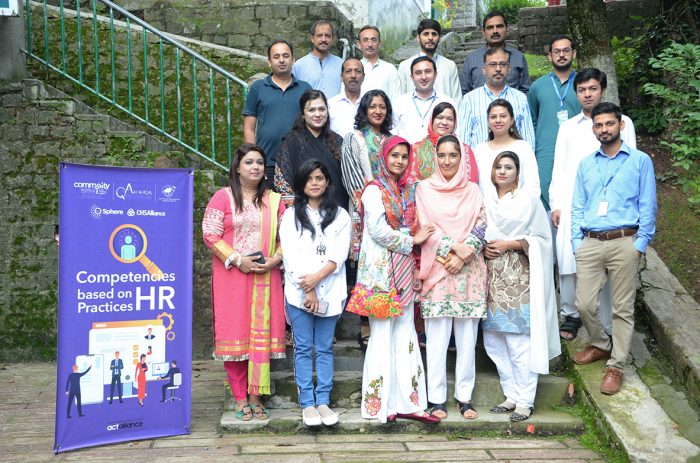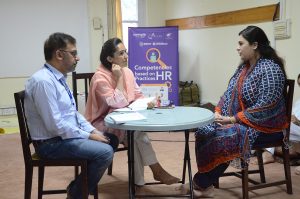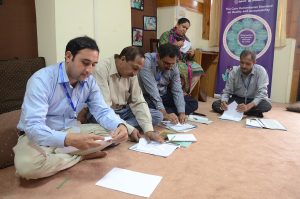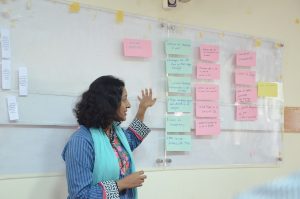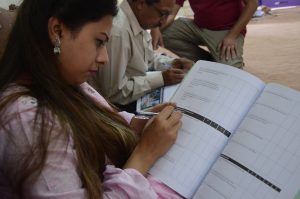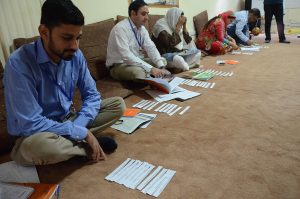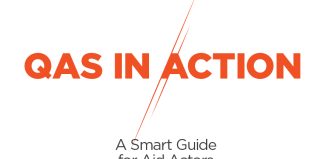Integrating the Competency-Based Approach to Strengthen Human Resources Management
Humanitarian and development organizations exist to support vulnerable and marginalized communities with the most high-quality, accountable and effective responses possible. This requires humanitarian and development staff who possess the right skills to achieve goals and overcome challenges inherent to humanitarian work. Supporting this aim, Community World Service Asia organized a four-day training course on competency-based human resources (HR) for 19 professionals from humanitarian and corporate organizations in Pakistan in July 2019.
Competency-based HR supports efficient and productive recruiting, training and management and is accelerating the professionalization of the humanitarian sector. The training—titled “Competency-based HR Practices Using the Core Humanitarian Competency Framework” (CHCF)—was based on the proven CHCF tool, developed in 2011.[1] The CHCF identifies a set of core competencies—including specific behaviors that support program quality or minimizing risk, for example—that serve as a reference and resource for humanitarian workers to guide the processes for both day-to-day and long-term decision making and management.
The trainer, Uma Narayanan, started the course by defining the notion of competency and showing how the results of a competency analysis can inform and improve the HR processes of performance management, recruitment and selection, employee development and employee compensation. She then divided participants into six groups of three each to practice applying the CHCF to strengthen their humanitarian response initiatives. Using questions based on the CHCF, two people in each group interviewed a candidate (the third participant in the group) for an HR position. Participants found the exercise to be helpful in decision-making, finding the right person for the right job and bringing more transparency into recruiting processes.
Uma explained, “Although the HR personnel does not have the technical knowledge of the hiring position, he or she can bring in observation skills during the interviewing sessions.” In facilitating the training, she leveraged her experience as a specialist in HR, quality management and organizational development in the humanitarian and development sector. With a background in International Organizational and Systems Development, she has worked as an Organization Development and HR practitioner mostly in Southeast Asia, South Asia and Europe, for more than a decade.
A competency-based framework also supports the performance development process by identifying what is critical for success; then, support and feedback can be focused accordingly. In the Competency-Based Performance Assessment session, participants carried out a self-assessment of their competencies using their job profile to help identify key areas of focus. Participants were directed to rate themselves on a scale of 0 to 3 under each competency, where 0 means the stated competencies are not required for current role, 1 is Not met/Partially met, 2 is Met and 3 is Exceeds/Advanced proficiency.
Sadia Usman, Vice President of HR for Shakarganj Food Products Limited, found the self-assessment to be very eye-opening.
As I am heading the HR department in my organization, I believed that I must exceed in most competencies. However, assessing myself with evidence made the rating process difficult. This was a healthy exercise to know how we are working in our field. While rating myself, I found out that I was partially meeting the competencies instead of exceeding them.
Finally, participants were presented with a set of motivating factors in the Learning and Development session, consisting of 10 features that encourage staff to perform better. The features included working conditions, salary and benefits, job status, management recognitions and others. Each participant was asked to arrange the motivating factors according to priority—what motivated them the most and the least. Participants learnt that the competency framework, in conjunction with the job description and the self-assessment tool, can be used to get to know their team’s current performance. Taken together, these helped the participants learn to make judgments on future potential, identify the areas for growth and recognize how these relate to aspiration, ability and engagement.
The attendees were excited to take these skills and tools back to their organizations. Isma Amin, Head of HR for Secours Islamique France-SIF, said,
The training was very interesting in terms of learning the CHCF. The group activities kept us engaged throughout the training, and each exercise complemented the session and built a clear understanding of the CHCF. Uma developed a friendly and open-sharing environment where all of us felt comfortable while sharing opinions.
Another participant, Samra Rehman, HR Manager for the International Federation of Red Cross, shared,
Being an HR professional, I believe I can improve some HR practices in my organization on my return. I plan to give an orientation session on the CHCF with the staff of IRC. Moreover, the competency framework for talent management can be exercised in our field of work which will transparently assess performance and potential of employees.
[1] Developed by representatives from a cross-section of humanitarian organizations under the auspices of the Consortium of British Humanitarian Agencies (now the Start Network).





